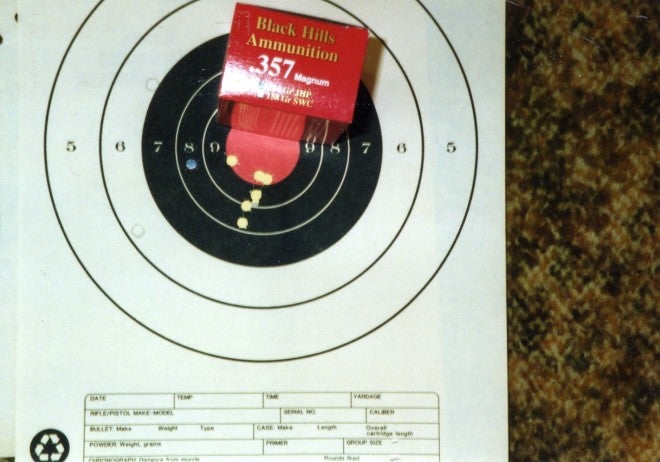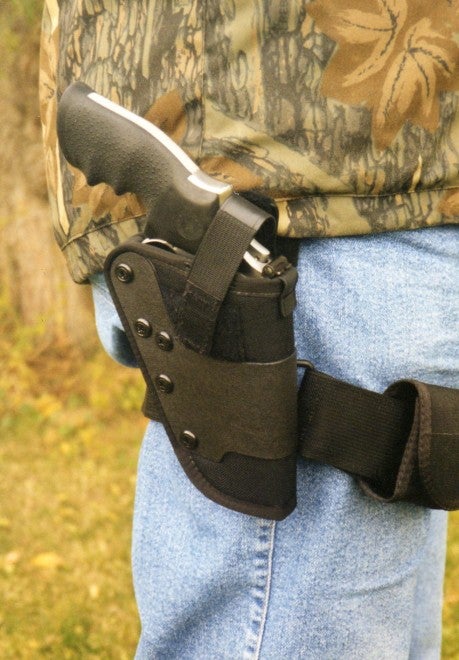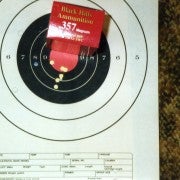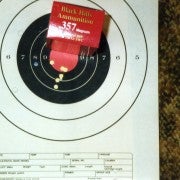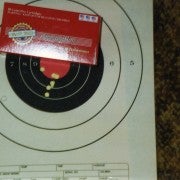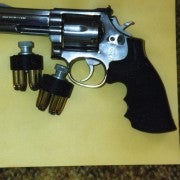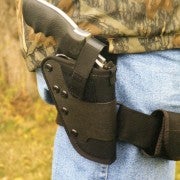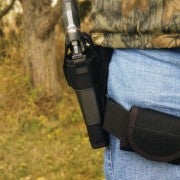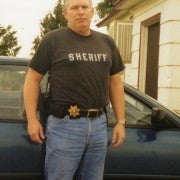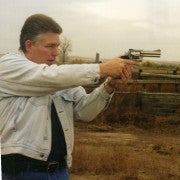The .357 Magnum for Survival: You Can’t Do Better
Pat Cascio 05.13.15

As a martial arts/firearms’ instructor, I’m often asked what constitutes the “best” gun for a survival situation. My stock answer is, “A good .357 Magnum stainless steel revolver with a 4-inch barrel.” However, when asked this question at other times, I’ll simply tell the person that the gun they are carrying is the “best” because it’s what they are carrying at the time they might need it.
But really, when it comes to the .357 Magnum, there isn’t a better gun/ammo combination anyone could ask for in an all-around “best” gun set-up. I don’t make this statement lightly, either. The .357 Magnum round in a good, solid, stainless steel revolver can put meat on the table or save your bacon if need be.
Some History
I’ll not delve into any great history of the mighty three fifty-seven. However, no article on this subject would be compete without mentioning a few things.
Production of the first three fifty-seven’s began in 1935 at Smith & Wesson under the direction of Major D.B. Wesson. The original guns were rather large (N frame) revolvers with 8 3/8″ barrles. This gun threw a 158 grain, lead semi-wadcutter bullet at over 1,500 fps. It was hailed as the “most powerful handgun in the world” (at time). Major Wesson proved the capability of the gun/ammo set-up during his fall hunt in Wyoming in 1935. Wesson killed antelope, moose, elk, and a grizzly bear with a brace of “three fifty-seven’s.” As an aside, Smith & Wesson had the name “.357 Magnum” registered as a trademark on April 23, 1935. S&W even went so far as to register the word “Magnum” as a trademark on June 4, 1935.
Stories abounded of the “killing power” of the new gun/ammo combination. The FBI reported that during the first year of production of the “Smith & Wesson .357 Magnum,” 63 agents purchased these guns, favoring the 3 1/2″ and 4″ barrel lengths. The very first registered Magnum to leave the S&W factory was an 8 3/4″ barrel Gun with serial number one. This went to J. Edgar Hoover, then director of the FBI.
My S&W 686
Enough history, though. What can the three fifty-seven Magnum do for you? Well, that’s purely a subjective question. I’ll give you my impressions and results.
I own a S&W model 686, stainless steel revolver with a 4” barrel. Nothing fancy has been done to this particular gun outside of replacing the factory grips with a set of Hogue rubber Monogrips. Matter of fact, this gun was picked-up in a trade. It was covered with scratches and the rear sight assembly was rusted.
A few minutes spent with some oiled, extra-fine steel wool on the rear sight removed the rust. Then the sight was re-blued with some cold bluing. The rest of the gun demanded a good cleaning, inside and out. Then, a soft towel was used with some auto “polishing compound” to remove the many scratches. No more than 45 minutes were spent refurbishing this gun. It looks almost factory new with very little effort.
I’m a habitual gun “trader.” I’m always trading or buying into something different. However, this particular model 686 has found a permanent home in my battery. Without a doubt, it is the best shooting revolver I own. Those who know me will attest to the fact that I’m a real fan of the semi-auto pistol. I carry one everyday on my right hip. I can shoot an autoloader better than a revolver most of the time.
Getting Results
The 686 was put through its paces at the local outdoor gun range. Using slow, single-action fire, I was able to place 6 rounds of Black Hills Ammunition 158 gr. JHP into a group of slightly over one inch at 25 yards. I don’t attribute this to my shooting skills, rather to the gun/ammo combo.
When I had but 4 rounds of .357 ammo left, I placed the target out to 50 yards. There was a slight cross wind blowing at the time. I did manage to place all 4 shots into a 3″ group. It was a tad low and to the left. I believe the cross wind had something to do with the rounds hitting a bit left of center. The heavier Remington 180 gr. rounds would probably have hit center. In all honesty, the gun is zeroed for 25 yards with 158 gr. JHP loads, so it is to be expected that it will hit a bit low at 50 yards.
Some hastily concocted handloads using Winchester 158 gr. JHP bullets using 15.0 grs. of Hodgdon H110 were also fired. Accuracy was dismal with this particular load at 25 yards. Grouping was no better than 4 inches. With some spare time and a little experimenting, I’m sure I can develop some handloads that will shoot accurately in this gun.
One of the sheer delights of owning a good .357 Magnum is that it can also fire the lighter recoiling .38 Special round. If you’re a novice to handgunning, one of the best ways to get started in shooting is with a light recoiling .38 Special load. It’s been reported over the years by many so-called gun “experts” that .38’s don’t shoot as accurately in the longer .357 chambered guns. Sometimes this is true and sometimes it’s not. My particular .357 was more than adequate with some .38 Special LSWC loads.
If you’re limited to owning one gun because of budgetary restraints or simply because you are only interested in owning one gun, the .357 Magnum is the route to go. When loaded with light .38 Special wadcutter loads, it’s the perfect gun for punching paper or taking small game like rabbit. When loaded with some standard or plus P .38 Special loads, it’ll serve most of your self-defense needs.
Additionally, if you’re in snake country, you can load the first few chambers with some snake loads. If you want to take medium to large game (Major Wesson did), the 158 gr. or 180 gr. loads will get the job done. For self-defense, the 125 gr. JHP load is the all-time best “manstopper” according to research done by ballisticians (retired police officer Ed Sanow and retired police detective Evan Marshall). They are reporting one-shot stops with most factory 125 gr. JHP loads at 96%. This is amazing now matter how you look at it! How much more versatile can you get?
Go Stainless for Survival
The reason I recommend a stainless steel .357 is because they are so weather resistant. Stainless steel really isn’t stainless–it’s only stain resistant and does require a certain amount of care. However, for the most part it’ll take just about anything Mother Nature cares to throw at it.
A firearm with ordinary bluing simply doesn’t stand up to the rigors you can put a stainless steel gun through. I used to live along the Oregon Coast (read: salt air). If I didn’t take my blue steel guns out once a month and wipe them down with a lightly oiled rag, they soon developed a light surface rust. Anything I owned made of stainless steel simply didn’t develop any sort of rust.
In this day of high capacity autoloaders, the good ol’ revolver is often overlooked for self-defense or survival. I find that I can conceal my model 686 in an Michaels of Oregon, Super Belt Slide holster without too much trouble. The gun is usually covered with either a jacket or outdoorsman’s type travel vest. When I choose to carry openly when hunting, I select the “Uncle Mikes” Tactical Thigh Holster. This is my all-time favorite (open) carry rig. The gun rides low on the thigh and is easily accessed. When carrying a backpack of any sort, a belt of shoulder holster gets in the way. However, the Tactical Thigh Holster makes carrying a pack, wearing a long coat or whatever equipment or clothing much easier because the gun is out of the way.
Now, I wouldn’t want to intentionally go hunting grizzly bear or moose with anything except a .357 magnum like Doug Wesson did. Nor would this gun/ammo set-up be my first choice if I were living in Alaska. No, I believe I would opt for a more powerful handgun. Something along the lines of a hot loaded .44 Magnum with a 6″ barrel or the proven .454 Casull revolver. We’re talking about the convenience of carrying a “handgun” for survival purposes. If I were intentionally hunting any sort of big-game, I would certainly carry the appropriate big-game rifle to get the job done.
We’re talking about S-U-R-V-I-V-A-L in this article. Be it survival on the mean streets of the big city or survival out in the wilderness. You can’t ask for a better arrangement than a good stainless steel .357 Magnum revolver and the proper load to get the job done. For the “average” person (and aren’t most of us “average?”), the .357 Magnum is the “best” choice.
On the Cheap
With a little shopping smarts, you can purchase a good, solid .357 Magnum revolver at about half the cost of a semi-automatic in 9mm, .40S&W, or .45ACP. Ammo is available in just about any weight/velocity you want. Additionally, you can still find .38 Special/.357 Magnum ammo in many drug stores and auto parts stores (at least out West). Try finding any sort of variety of .44 Magnum ammo anyplace except a gun store–can’t be done!
If you’re a handloader, you can do a little experimenting and come up with some real accurate loads for your particular gun. If you decide to purchase factory ammo, you’re not at any serious disadvantage either.
Another thing to keep in mind is the anti-gun crowd we have in Washington, D.C. Thus far, they haven’t set their sights (no pun intended) on revolvers. Their big concern is to take the so-called “assault” guns out of the hands of honest, law-abiding citizens.
A good .357 Magnum revolver loaded with some hot stepping .125 gr. JHP ammo and a spare speed loader or two should get you out of just about any lethal threat you may find yourself in. With a modicum of practice, you can reload a revolver in under 6 seconds with a speed loader. That ain’t half bad, and if you’re serious about saving your hide, you’ll be behind some sort of cover” while you’re reloading. In a hunting situation, you shouldn’t have to worry about a speed reload, so spare rounds can be carried in belt loops if you so desire.
No, any way you look at it, the .357 Magnum gun/ammo is the “best” route to go if you’re serious about your S-U-R-V-I-V-A-L! Give it some thought; you won’t be sorry.
